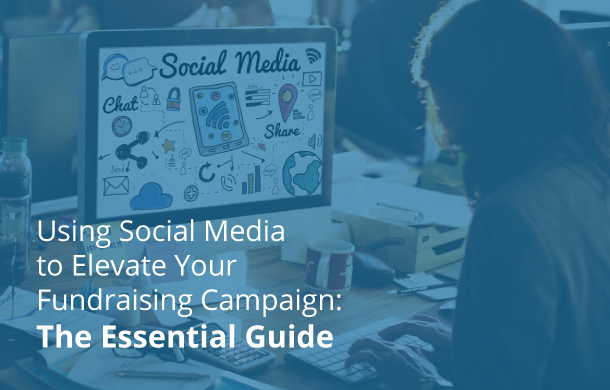 As your nonprofit plans its next fundraising campaign, take some time to evaluate your social media strategy. Whether you’re well-established across several platforms or making your first forays into the world of social media, it’s worthwhile to consider how your organization could better utilize sites like Facebook, Twitter, and Instagram.
As your nonprofit plans its next fundraising campaign, take some time to evaluate your social media strategy. Whether you’re well-established across several platforms or making your first forays into the world of social media, it’s worthwhile to consider how your organization could better utilize sites like Facebook, Twitter, and Instagram.
Social media sites instantly connect your nonprofit to vast numbers of current and potential donors. You can use each popular platform’s unique features to your organization’s advantage, appealing to different groups of donors using images, posts, and real-time updates that are sure to captivate and inspire them.
First, we’ll take a look at how social media can shed light on your nonprofit and all the good work it does. Then we’ll show you which forms of fundraising are perfect fits for a campaign focusing on social media appeals. Let’s consider how your organization can use social media to:
- Tell a compelling story.
- Give tech-savvy supporters new ways to donate.
- Incorporate peer-to-peer fundraising.
- Connect your fundraising campaign to an event.
- Create your next social media appeal using donor data.
Join us as we enter the fast-moving and highly effective world of fundraising through social media! Let’s get started by forming the foundation of your social media strategy: your organization’s story.
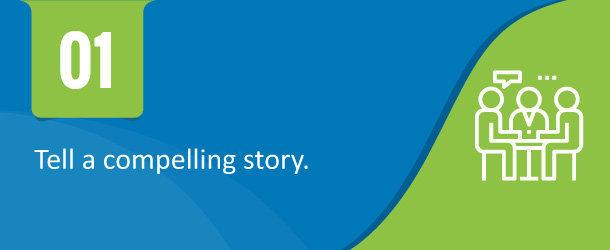
1. Tell a compelling story.
You won’t be surprised to learn that your donors want to know the story behind your organization and your latest project. Your nonprofit’s story helps form personal connections between your donors and your organization.
By structuring your communications with donors as narratives, you let them know why their contributions are necessary and make them feel like important parts of your organization. Stories that show donors how their contributions are being used also communicate that your organization is trustworthy, an important consideration for online donation platforms in particular.
Just as a good story helps your donors recognize their individual importance, it can also personalize your nonprofit’s appearance by focusing on smaller units of your organization. Effective and shareable stories are often those that highlight the work of individual volunteers or workers, or developments and updates within a larger project.
Storytelling makes your work more appealing to donors because it provides them with a clearer understanding of the work your nonprofit does and how your organization accomplishes that work on a daily basis.
Social media sites are the perfect place to share your organization’s stories. As you develop your next narrative, use social media to incorporate:
Multimedia capabilities
Pictures are easy to share and view across most platforms and are the focus of photo-sharing sites like Instagram. They’re great for emotional appeals.
Not quite sure if your organization’s work is visually striking? Try a picture of one of your hard-working employees or volunteers to help build those all-important personal connections between your organization and your donors!
Don’t forget other media! Videos can be great for spotlighting individuals involved in your cause and can teach viewers a lot about your organization, projects, and campaigns in short amounts of time.
Real-time updates
An effective storytelling strategy is often one that reveals your work to your followers as it’s happening. Short posts or pictures detailing progress and updates let your donors be part of the project with you!
Use this kind of update post to let your followers know how close you are to reaching your donation goal or how many days remain until your event. They’ll be motivated to donate as the goal or deadline approaches!
Interaction with your donors
Want to give recent donors the public recognition they deserve in a place they’re sure to see? Thank them by name on social media, especially if they encountered your organization through a specific platform. Thank-you posts are an easy way to make your donors a part of your story!
A compelling social media story, complete with pictures, videos, project updates, and thank-you posts, is sure to transform more of your organization’s followers into donors. Make the process as convenient as possible for them by providing multiple options for online donation.
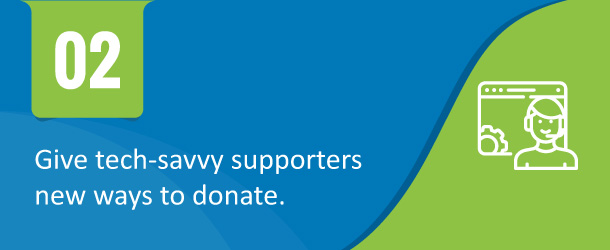
2. Give tech-savvy supporters new ways to donate.
If your supporters are following your organization on social media, it’s likely that they’re a tech-savvy group who would appreciate the opportunity to donate to your campaign online.
Keep your online giving page as close to your social media profiles as possible! Remember that each of your posts serves as an incentive for donors to give, so make it easy for them to do so.
Now is the time to reassess your online and mobile giving capabilities. What does your giving page look like? How easy and fast is it to use? Importantly, how quickly can donors access it from key social media sites like Facebook, Twitter, and Instagram?
Whether you’re restructuring your social media profiles or creating them for the first time, make sure that they show your followers where they can donate online. To appeal to donors who find your organization on social media, consider the following options:
- An online giving form. This is a must-have! Try to make sure that it’s no more than a click away from any of your social media posts, especially if you’re currently showcasing your fundraising campaign. The form should be branded to your organization and as simple to use as your can make it.
- Mobile giving. Social media sites are largely accessed on smartphones, and millennials want to give from their phones. Make it possible with a mobile-responsive giving page that looks and works great on computers, tablets, and smartphones alike!
- Go one step further with text-to-give! If your organization uses online fundraising software with text-to-give capabilities, your nonprofit will receive a number that donors can text for a link to your mobile giving form. This process can be made even easier with a system that uses email authentication as a password alternative! If your organization is on Instagram, share a picture of a sample text showing your number to your followers!
- Personalized receipts for your online mobile donors. They’ve followed your campaign on social media and they’ve made their contribution, so don’t forget to thank them right after!
If your donors are at home with social media and online giving, why not put them in the fundraiser’s role in your next campaign? Peer-to-peer fundraising is a strategy tailored to social media that turns key donors into volunteer fundraisers.
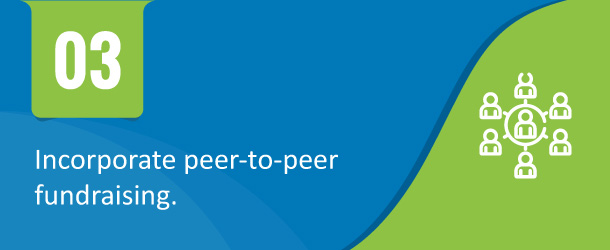
3. Incorporate peer-to-peer fundraising.
Whether your organization has already found success on social media or wants to break into this sphere with more experience on its side, consider incorporating peer-to-peer fundraising in your next campaign. In peer-to-peer fundraising, your donors become volunteer fundraisers, sharing personalized campaign pages across their own social media networks.
While your volunteer fundraisers are responsible for sharing the campaign and expressing their personal reasons for supporting your organization on their pages, all of the money they raise ultimately returns to your nonprofit!
Cost-effective and popular, especially among younger generations of donors, here’s why you should incorporate peer-to-peer fundraising in your next social media-driven campaign:
- Peer-to-peer fundraising uses social media to strengthen relationships with your current donors. Donors who have contributed regularly, in large amounts, or have volunteered with your organization in the past are all great candidates for volunteer fundraisers. Their pages will demonstrate why they’ve chosen to become personally involved with your cause.
- It also draws in new ones from large networks. Your nonprofit may have a limited reach on social media platforms, especially if you’re just starting to make your presence known there. Your volunteer fundraisers, however, likely have large networks already built up.
- Its competitive elements contribute to your campaign’s story. Gamification is a key component of peer-to-peer fundraising, and social media provides the perfect public grounds for a little friendly competition.
Set a time limit, perhaps the date of an event, and challenge your volunteer fundraisers to compete for the most money raised. Post updates on the rankings or congratulations to the winner on your organization’s profiles!
Peer-to-peer fundraising campaigns are often tied to community events. If you want to engage your social media followers and online donors in the real world, invite them to an event that will strengthen their relationship with your organization!
Want to see expert peer-to-peer fundraising tools in action? Head on over to Snowball Fundraising, where you’ll learn how your nonprofit can start raising more for your cause with the help of dedicated volunteer fundraisers.

4. Connect your fundraising campaign to an event.
Your donors have followed your organization’s campaign through the stories you have created using social media. They’ve been inspired to donate and perhaps even to become volunteer fundraisers themselves through peer-to-peer fundraising. Now it’s time to engage with them offline.
The benefits of hosting a fundraising event are numerous. They strengthen your donors’ personal involvement with your cause, allow donors to meet their fellow supporters, and facilitate opportunities for learning more about your nonprofit and its work.
You can use social media to invite your donors to events and encourage them to donate in anticipation. Consider strategies like:
- Inviting your donors. Repeated posts on their favorite sites will help them remember to make their donations and attend!
- Counting down to the event. Get your supporters excited with short but regular countdown posts. Expect an increase in donations as the date gets closer.
- Connecting your event countdown to your organization’s progress. Don’t forget your storytelling strategies as the event gets closer. As your supporters prepare to engage with your organization in person, they’ll be even more interested in the details of your current project and where their donations are headed.
A successful fundraising campaign is a big achievement, and one that you can repeat! If you owe your success to social media, ensure that you’re using your donor database effectively so that you know where and how to reach online donors next time!
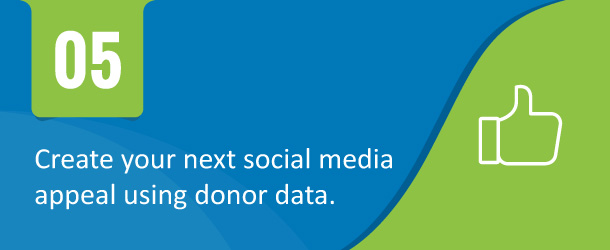 5. Create your next social media appeal using donor data.
5. Create your next social media appeal using donor data.
If you’ve had success connecting with donors over social media and are seeing an increase in donations via online or mobile giving, a successful peer-to-peer campaign, or associated events, take advantage of this information!
What worked well in your last social media-based campaign, and what may not have gone as expected? What approaches worked with donors of various age groups? What social media platforms are bringing the most donors your way?
After your campaign has ended and you’re working on your next social media strategy, the information in your donor database becomes even more crucial. Check out Double the Donation’s guide to become a nonprofit CRM expert, and then leverage your donor data to determine where your strategy was effective and where it may need some work.
For instance, on how many social media platforms should your organization have a presence? While it’s great to diversify your approach with profiles across multiple platforms in order to reach more donors and utilize more features, your reports may indicate that focused strategies for a few key sites may be the way to go.
Your organization can develop a strong social media presence by understanding your donors’ favorite platforms and using their unique features to tell captivating stories. When you combine a flair for narrative with easy-to-use and effective online donation tools, your social media followers are likely to become dedicated donors.
John Killoran is CEO of Snowball, an exciting new fundraising technology that makes it easy for people to donate in two clicks from text, email, web and social media sites. John pioneered SMTP payments and has been a major innovator in the mobile payments space for the past 5 years. When he is not running a company, he is cooking food for his family and telling his dogs to stop barking.

